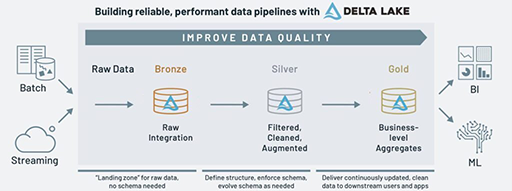When is an Aggregate not an Aggregate?

I am irked.
As a father of two high school aged children, this is not uncommon, but for once they are not the source of my ire.
On this occasion, it’s the following widely distributed image, taken from the Databricks website:
What’s the matter?
My issue is with the description of the Gold layer, specifically the phrase “Business-level Aggregates”.
What’s in a word?
-
It means you took the data from a lower grain to a higher grain. In other words, when you look at an aggregate, it means you're not looking at the lowest level of detail of which the data is available.
-
Sum, count, avg, min, max etc
-
Those functions that break SQL because I forget the group by... Or more sensible answer - the functions to summarise my data - SUM COUNT being the obvious 2
Most of my Twitter followers are fellow data professionals, and the most common answers from that particular audience all followed a theme, involving using some kind of mathematical function to summarize data.
Framed as a fairly open ended question, I don’t think any of those answers are incorrect. And if we take dictionary definitions, that fits ok too. One definition is as follows:
A sum or assemblage of many separate units; sum total
But “aggregate” is one of those wonderful marvels of the English language known as a homonym. It’s a word that can actually have several different meanings.
From the same Collins Dictionary entry as the above definition, we have an alternative:
Formed of separate units collected into a whole; collective;
Ambiguity
The default word association of many data professionals is the former definition, leading many people to believe that the “Gold” layer of the Lakehouse means pre-aggregated data. But despite the plethora of plaid shirts in our midst, this is not the 90’s and we’re not supposed to be trying to mimic the early incarnations of OLAP cubes.
I like to think of this version of “aggregates” to be akin to a news aggregator website. The purpose of those types of website is to curate the best sources of news and bring them all together in one place, making it easier for people to consume information about the current affairs of the day. The intention is not to summarize that news in a set of TLDR-esque snippets. You get the articles in full from many different places, but served up in an easier to navigate manner.
The Microsoft Bing homepage is a good example of a news aggregator website.
Sound familiar? A well designed data warehouse, or gold/curated layer in a Data Lakehouse does the same thing! Taking data from disparate sources, consolidating it in to a defined set of objects that transcend those sources and serving them up in a manner that end users can consume in order to make sense of their business and drive decisions.
Aggregation Confusion
In fact, when you actually read the accompanying literature with the now infamous Databricks diagram, there is zero mention of the word aggregate. The emphasis is much more on curation and modelling. Which make me wish they would just change the damn diagram and remove the ambiguity.
There are cases when summarising the data makes sense. Maybe you need to roll up to a common grain to conform a concept across separate sources or as a means to help boost performance in some scenarios, so the SQL engine doesn’t have to scan so much data. But these should still be built on top of data already modelled at the atomic grain, not as replacement for them.
Rant Over!
This article was originally written on behalf of and published by Advancing Analytics in December 2023. You can visit the original article here.

